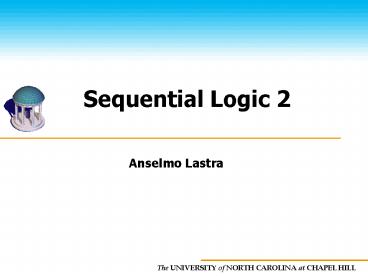Sequential Logic 2 PowerPoint PPT Presentation
1 / 41
Title: Sequential Logic 2
1
Sequential Logic 2
- Anselmo Lastra
2
Administrative
- Make sure you have access to lab and ModelSim for
homework - I hear there were some ModelSim license problems
- How are things going?
- Problems understanding?
- Too easy / too hard?
3
Verilog
- Forgot to mention useful for tests
- stop
- Stops the simulation
- So you can hit run all button to run complete
sim program
4
Topics
- Flip-Flops
5
Review D-type Latch
- No illegal state
6
Problem of Transparency
- As long as C high, state can change
- Whats problem with that?
7
Effects of Transparency
- Output of one latch may feedback
- So more state changes may happen
- Depends on gate delays
- Want to change latch state once
- Depending on inputs at time of clock
8
Flip-Flops
- Ensure one transition
- Two major types
- Master-Slave
- Two stage
- Output not changed until clock disabled
- Edge triggered
- Change happens when clock level changes
9
Master-Slave Flip-Flop
- Either R (master) or L (slave) is enabled, not
both
10
Timing Diagram
- Trace the behavior
- Note illegal state
11
Still Have SR Illegal State
- Can use similar approach as for D
12
JK Master-Slave FF
- Output gates J K so if JK both high, next Q is
inverse of current one
13
Have We Fixed Problem?
- Output no longer transparent
- Combinational circuit can use last values
- New inputs appear at latches
- Not sent to output until clock low
- But changes at input of FF when clock high
trigger next state - Transient state where S goes high caused by gate
delays - As clock faster, more problems
- Have to guarantee circuit settles while clock low
14
Edge-Triggered Flip-Flops
- New state latched on clock transition
- Low-to-high or high-to-low
- Changes when clock high are ignored
- Note Master-Slave also called pulse triggered
15
D-Type Edge Triggered
16
Negative edge D-type
- From WebPACK
17
Behavioral
18
Flip-Flop Timing
- Draw on board
- Setup time time that D must be available before
clock edge - Hold time time that D must be stable after
clock edge - Propagation delay time after edge when output
is available
19
Edge-Triggered JK
- Same truth table as other JK flip-flop, but edge
triggered
20
Standard Symbols Latches
- Circle at input indicates negation
21
Symbols Master-Slave
- Inverted L indicates postponed output
- Circle indicates whether enable is positive or
negative
22
Symbols Edge-Triggered
- Arrow indicates edge trigger
23
Characteristic Tables
- Can describe function of flip flops by
considering state - Current state
- Next state at clock pulse governed by inputs
- Concept of state at times useful
24
JK and SR Flip-Flops
25
T Flip-Flop
- Similar to D, except T input governs whether
state changes or not - Instead of whether Q is 1 or 0
26
Clock Gating
- Can gate clocks (like to keep any FF from
changing states) - However, can cause clock skew
- Clock skew also caused by wire lengths over chip
27
Direct Inputs
- Set/Reset independent of clock
- Direct set or preset
- Direct reset or clear
- Often used for power-up reset
28
Verilog for Sequential
- Add some new Verilog to describe sequential
circuits - Can use latches and flip-flops from library in
schem. capture or Verilog - And connect them
- But more productive to write higher-level Verilog
description
29
Register Data Type
- Like wire but value is retained over time
- Often causes latch or FF to be synthesized
- Examples
- reg state
- reg 150 addr
30
Always Block
- Example
- always _at_ (Reset or Reset)
- statement
- Sensitivity list determines what might affect
statements - Could think of it as statement is run when one
of nets in sensitivity list changes value - Example next
31
Flip-Flop Example
- module dff_v(CLK, RESET, D, Q, Q_n)
- input CLK, RESET, D
- output Q, Q_n
- reg state
- assign Q state
- assign Q_n state
- always _at_(posedge CLK or posedge RESET)
- begin
- if (RESET)
- state lt 0
- else
- state lt D
- end
- endmodule
negedge also used
32
This is Not Software
- Dont assign to same reg in more than one always
block - The always blocks are concurrent
- Doesnt make sense to set reg from two signals
- Assignments in always blocks should be
non-blocking - You usually dont mean sequential execution
33
Analysis of Sequential Circuits
- Earlier we learned how to analyze combinational
circuits - Now extend to synchronous sequential
- Include time
- Time will be governed by clock, so discrete
- Well use state tables and state diagrams
34
Input Equations
- Can describe inputs to FF with logic equations
35
Another Example
36
Time is Implied
- If circuit is synchronous, time implied as
sequence of clock ticks - Note that last circuit used
- Previous state to determine next state
- State and inputs to determine output
37
State Table
- For last example
- Truth table with state added
38
Two Dimensional Table
- Same thing, different layout
39
Sequential Circuit Types
- Moore model outputs depend on states
- Mealy model also depend on inputs
40
Today
- Flip-Flops
- Verilog always statement
- Notion of state and next state
41
Next Time
- State Diagrams
- Registers

